 If you are hitting the farmers’ market within the next few weeks, it will be obvious that melon season has arrived!
If you are hitting the farmers’ market within the next few weeks, it will be obvious that melon season has arrived!
There are many ways to enjoy local, in-season melons, but do you ever wonder…
what to look for?
how to pick the most flavorful ones?
what’s the best way to store them?
There are some tips and tricks that can help you get the most out of all the delicious, juicy fruits of summer!
There are so many varieties of melons to pick from, and we encourage trying as many as you can! One of the melons we start craving every year at this time is the canary melon. We discovered this melon a couple of years ago after talking to a few local farmers and, after our first taste said, “I can’t believe we’ve been missing out on this all these years!” The canary melon is bright yellow on the outside (hence the canary name) and pale green/white on the inside. Its flavor is similar to a cantaloupe, but it doesn’t get as mushy — which we love!
What are the different types of melons?
Melons actually come from the gourd family and there are several types, but there are three which are most relevant for us: muskmelons, inodorous melons and watermelons.
 Muskmelons include cantaloupes and a range of different varieties in different parts of the country. These melons have a distinct aroma, a “netted” skin and are typically harvested when the vine slips off the fruit. They are best enjoyed shortly after they ripen. Other varieties include Galia, Persian and Charentais.
Muskmelons include cantaloupes and a range of different varieties in different parts of the country. These melons have a distinct aroma, a “netted” skin and are typically harvested when the vine slips off the fruit. They are best enjoyed shortly after they ripen. Other varieties include Galia, Persian and Charentais.
 Inodorous melons include varieties such as canary, casaba and honeydew as well as varieties we may not be as familiar with such as the Crenshaw and Santa Claus melon. Yes, there is even a Santa Claus melon (a.k.a. the Christmas melon)! It gets its name because of its late season harvest and its ability to stay fresh through the holidays. These inodorous melons tend to have a thicker and smoother skin and typically lack any distinct pre-cut aroma.
Inodorous melons include varieties such as canary, casaba and honeydew as well as varieties we may not be as familiar with such as the Crenshaw and Santa Claus melon. Yes, there is even a Santa Claus melon (a.k.a. the Christmas melon)! It gets its name because of its late season harvest and its ability to stay fresh through the holidays. These inodorous melons tend to have a thicker and smoother skin and typically lack any distinct pre-cut aroma.
 Watermelons, of course, need no introduction. There are different varieties of watermelons, which include flesh that can be red, pink, orange, yellow, green or even white. Some say the yellow-flesh varieties have a more mellow taste, with a hint of honey. Some have black or purple rinds. Seedless watermelons are obviously very popular. These seedless varieties were invented over 50 years ago and many actually do have seeds, but the seeds are immature, white and very soft (and are, of course, safe to eat).
Watermelons, of course, need no introduction. There are different varieties of watermelons, which include flesh that can be red, pink, orange, yellow, green or even white. Some say the yellow-flesh varieties have a more mellow taste, with a hint of honey. Some have black or purple rinds. Seedless watermelons are obviously very popular. These seedless varieties were invented over 50 years ago and many actually do have seeds, but the seeds are immature, white and very soft (and are, of course, safe to eat).
What are the growing conditions for melons?
Bees are needed to pollinate melons and a lot of water is required during the growing season. However, in the few weeks leading up to harvest, the sweetest melons are produced in drier conditions. If there is a lot of rain in the few weeks leading up to harvest, this can adversely affect the end result. Most melons ripen in mid to late summer or early to mid-fall.
How do you pick a good one?
 Tap it! Thump it! Slap it! Have you ever wondered what people are listening for when they do this? If you hear a deep and thick dense sound, that is a good sign. A hollow sound can mean lack of moisture.
Tap it! Thump it! Slap it! Have you ever wondered what people are listening for when they do this? If you hear a deep and thick dense sound, that is a good sign. A hollow sound can mean lack of moisture.- Take a whiff! Many melons will have a stronger aroma as they become ripe. Cantaloupes will have a “musky” smell, which is especially evident when they are left at room temperature (and I can tell you from experience, this is very evident if you leave them in a hot car!).
- Listen up! Muskmelons will have a slight rattle when you shake them because the center seeds will loosen when ripe.
- Heavyweights! Melons should feel heavy for their size. Since watermelon is made up of mostly water, the heavier the better.
- Touch it! Some of the inodorous melons (like the canary melon) will have a sticky or tacky feel as they ripen…this is because the sugars start to saturate the rind. These melons should be firm, except the blossom end (opposite the stem) of some melons like honeydew should have a slight give.
- Color! For a ripe melon, the rind will typically be dull…not shiny. With watermelons, a great way to test for ripeness is to look at the spot where the melon rested on the ground. If it is slightly yellow, this is a good sign and suggests ripeness. If it is white or pale green, it may not have ripened yet. If the watermelon has stripes, the area between the stripes should be a light green. Keep in mind, once a watermelon is harvested, it is not likely to ripen further (unlike a peach or other produce, which ripens even after being harvested).
How do you store a melon?
Cantaloupes are best enjoyed shortly after you get them home. You can also store a whole cantaloupe in the fridge for about five days after it ripens (the refrigerator crisper works great if you have room). Uncut watermelons can remain at room temperature for up to 2 weeks. Some of the inodorous melons including canary and Christmas melons will last a month or more uncut at room temperature. Once they are cut, melons will generally remain good for a week if stored in a sealed covered container in the refrigerator.
Why are melons good for us?
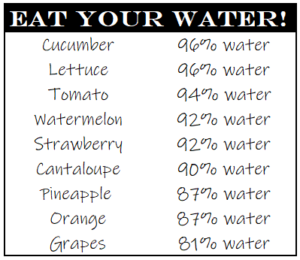 Cantaloupes and honeydew melons are good sources of Vitamin B6, niacin and folate. Cantaloupe is also high in Vitamin A for healthy vision.
Cantaloupes and honeydew melons are good sources of Vitamin B6, niacin and folate. Cantaloupe is also high in Vitamin A for healthy vision.
Watermelons provide lycopene which have been shown to help protect against certain types of cancer. Melons overall have been shown to help aid in digestion, maintain healthy skin, prevent kidney disease, help cure acute eczema, prevent blood clots and even relieve heartburn.
And because they have a high water content, they will help keep you hydrated in the hot summer weather. Pretty powerful fruit!
There are so many delicious ways to enjoy melons this summer!
Your family and friends will be raving about this Steak, Tomato and Watermelon Salad
And there are more great ideas:
Summer Explosion Salad (aka Tomato Cantaloupe Salad)
Minty Cucumber Cantaloupe Salad
Balsamic Watermelon Chicken Salad
Red, White and Blueberry Salad
Grilled Seafood with Summer Melon Salsa
Hopefully, this helps for your next melon purchase…whether at the farmers’ market or the store. At least we will LOOK like we know what we are doing!
 LEARN MORE ABOUT THE NAPKIN!
LEARN MORE ABOUT THE NAPKIN!
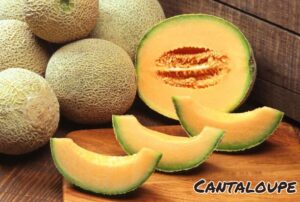

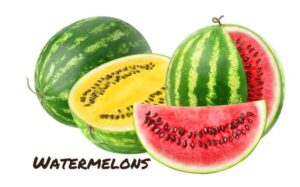
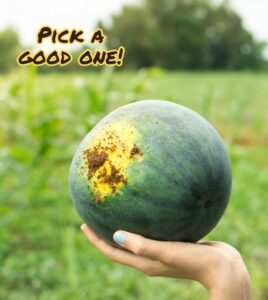
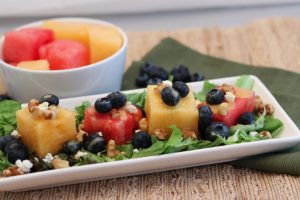
I appreciate these tips on finding a good melon. I am always afraid when I have to pick one out if it will be good or not.